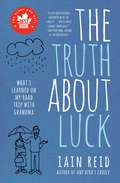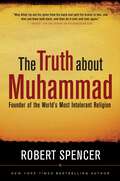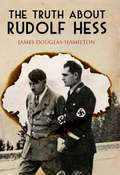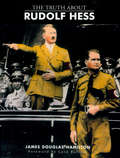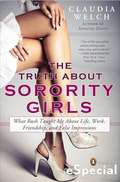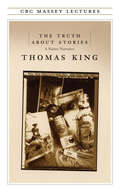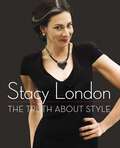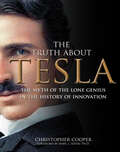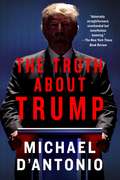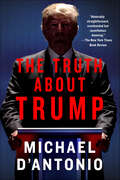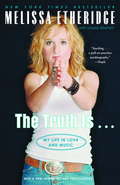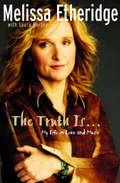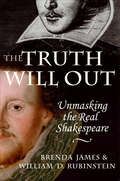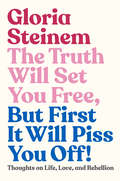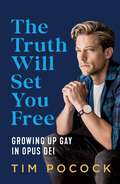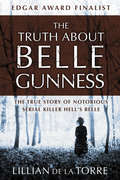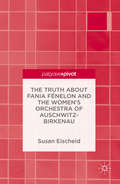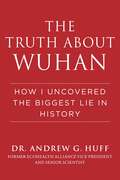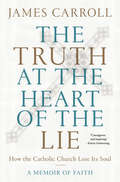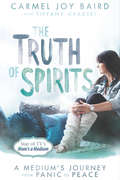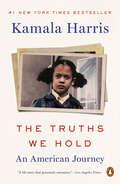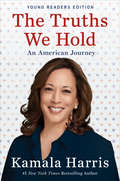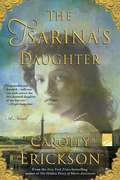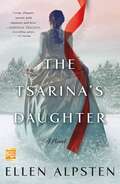- Table View
- List View
The Truth About Luck: What I Learned on My Road Trip with Grandma
by Iain ReidSelected for The Globe 100 Books in 2013. In The Truth about Luck, Iain Reid, author of the highly popular coming-of-age memoir One Bird's Choice, accompanies his grandmother on a five-day vacation — which turns out to be a "staycation" at his apartment in Kingston. While the twenty-eight-year-old writer is at the beginning of his adult life, his ninety-two-year-old grandmother is nearing the end of hers. Between escorting his grandma to local attractions and restaurants, the two exchange memories and she begins to reveal details of her inspiring life story. Told with subtlety, humour, and heart, this delightful comic memoir reflects on family connections; how we experience adversity, the passage of time, and aging; and most importantly what it truly means to feel lucky.
The Truth About Muhammad: Founder Of The World's Most Intolerant Religion
by Robert SpencerMuhammad: a frank look at his influential (and violent) life and teachingsIn The Truth about Muhammad, New York Times bestselling author and Islam expert Robert Spencer offers an honest and telling portrait of the founder of Islam-perhaps the first such portrait in half a century-unbounded by fear and political correctness, unflinching, and willing to face the hard facts about Muhammad's life that continue to affect our world today.From Muhammad's first "revelation" from Allah (which filled him with terror that he was demonpossessed) to his deathbed (from which he called down curses upon Jews and Christians), it's all here-told with extensive documentation from the sources that Muslims themselves consider most reliable about Muhammad.Spencer details Muhammad's development from a preacher of hellfire and damnation into a political and military leader who expanded his rule by force of arms, promising his warriors luridly physical delights in Paradise if they were killed in his cause. He explains how the Qur'an's teaching on warfare against unbelievers developed-with constant war to establish the hegemony of Islamic law as the last stage.Spencer also gives the truth about Muhammad's convenient "revelations" justifying his own licentiousness; his joy in the brutal murders of his enemies; and above all, his clear marching orders to his followers to convert non-Muslims to Islam-or force them to live as inferiors under Islamic rule.In The Truth about Muhammad, you'll learn- The truth about Muhammad's multiple marriages (including one to a nine-year-old) - How Muhammad set legal standards that make it virtually impossible to prove rape in Islamic countries - How Muhammad's example justifies jihad and terrorism - The real "Satanic verses" incident (not the Salman Rushdie version) that remains a scandal to Muslims - How Muhammad's faulty knowledge of Judaism and Christianity has influenced Islamic theology--and colored Muslim relations with Jews and Christians to this day.Recognizing the true nature of Islam, Spencer argues, is essential for judging the prospects for largescale Islamic reform, the effective prosecution of the War on Terror, the democracy project in Afghanistan and Iraq, and immigration and border control to protect the United States from terrorism.All of which makes it crucial for every citizen (and policymaker) who loves freedom to read and ponder The Truth about Muhammad
The Truth About Rudolf Hess
by James Douglas-HamiltonRudolf Hess' flight to Britain in May 1941 stands out as one of the most intriguing and bizarre episodes of the Second World War.In The Truth About Rudolf Hess, Lord James Douglas-Hamilton explores many of the myths which still surround the affair. He traces the developments which persuaded Hess to undertake the flight without Hitlers knowledge and shows why he chose to approach the Duke of Hamilton. In the process he throws light on the importance of Albrect Haushofer, one-time envoy to Hitler and Ribbentrop and personal advisor to Hess, who was eventually executed by the SS for his involvement in the German Resistance movement.Drawing on British War Cabinet papers and the authors unparalleled access to both the Hamilton papers and the Haushofer letters, this new and expanded edition of The Truth About Rudolf Hess takes the reader into the heart of the Third Reich, combining adventure and intrigue with a scholarly historical approach.
The Truth About Rudolf Hess
by Lord James Douglas-HamiltonRudolf Hess's flight to Britain in May 1941 stands out as one of the most intriguing and bizarre episodes of the Second World War. In The Truth About Rudolf Hess, Lord James Douglas-Hamilton explodes many of the myths which still surround the affair. He traces the developments which persuaded Hess to undertake his flight without Hitler's knowledge and show why he chose to approach the Duke of Hamilton. In the process he throws new light on the importance of Albrecht Haushofer, one-time envoy to Hitler and Ribbentrop and personal advisor to Hess, who was eventually executed by the S.S. for his involvement in the German Resistance movement. Drawing on British War Cabinet papers and the author's unparalleled access to the Hamilton archives and the Haushofer letters, The Truth About Rudolf Hess takes the reader to the heart of the Third Reich, combining adventure and intrigue with a scholarly historical approach. This remarkable book is illustrated throughout with superb photographs, placing the fascinating story in true historical perspective.
The Truth About Sorority Girls
by Claudia WelchAcclaimed author of Sorority Sisters Claudia Welch reveals the truth about her own life as a sorority girl--and it's nothing like you'd expect. Who doesn't have a ready-made image of a sorority girl? They're rich, stuck-up, brainless, and mean--right? Wrong. I don't live in a sorority house anymore, but the experiences I had there are still with me. I'm still friends with my sorority sisters, and I consider the days I spent with them in college to be some of the best of my life. In the most basic, positive and profound ways, being in a sorority has helped me to become the person I am today. So, to separate fact from fantasy, I am prepared to tell you the whole truth about my sorority life, and share some of the lessons I learned along the way. Also included: an excerpt of Claudia Welch's novel Sorority Sisters!
The Truth About Stories: A Native Narrative (The CBC Massey Lectures)
by Thomas KingWinner of the 2003 Trillium Book Award "Stories are wondrous things," award-winning author and scholar Thomas King declares in his 2003 CBC Massey Lectures. "And they are dangerous." Beginning with a traditional Native oral story, King weaves his way through literature and history, religion and politics, popular culture and social protest, gracefully elucidating North America's relationship with its Native peoples. Native culture has deep ties to storytelling, and yet no other North American culture has been the subject of more erroneous stories. The Indian of fact, as King says, bears little resemblance to the literary Indian, the dying Indian, the construct so powerfully and often destructively projected by White North America. With keen perception and wit, King illustrates that stories are the key to, and only hope for, human understanding. He compels us to listen well.
The Truth About Style
by Stacy LondonThe New York Times bestselling style guide from the cohost of What Not to Wear It&’s clear why Women&’s Wear Daily hails Stacy London as &“the Dr. Phil of fashion.&” Since 2002, she&’s transformed hundreds of guests on TLC&’s hit show What Not to Wear. But London has more than just impeccable taste. She has a gift for seeing the core emotional issues behind a disastrous wardrobe. By sharing her own struggle with self-esteem, London illustrates how style develops confidence. Including invaluable fashion tips, advice, and a revelatory makeover section, The Truth About Style is for London&’s legion of fans—and everyone who longs to enhance and celebrate the body she has.
The Truth About Tesla: The Myth of the Lone Genius in the History of Innovation
by Christopher CooperA myth-busting biography of Nikola Tesla, the “enigmatic figure whose life and achievements appeal to historians, engineers, scientists, and many others” (Library Journal).Nikola Tesla, one of the greatest electrical inventors who ever lived, was rescued from obscurity in recent years, restored to his rightful place among historical luminaries. We’ve been told that his contributions to humanity were obscured by a number of nineteenth-century inventors and industrialists who took credit for his work or stole his patents outright. Most biographies repeat this familiar account of Tesla’s life, including his invention of alternating current, his falling out with Thomas Edison, how he lost billions in patent royalties to George Westinghouse, and his fight to prove that Guglielmo Marconi stole thirteen of his patents to “invent” radio. But what really happened?Newly uncovered information, however, proves that the popular account of Tesla’s life is itself very flawed. In The Truth About Tesla, Christopher Cooper sets out to prove that the conventional story not only oversimplifies history, it denies credit to some of the true inventors behind many of the groundbreaking technologies now attributed to Tesla, and perpetuates a misunderstanding about the process of innovation itself.Are you positive that Alexander Graham Bell invented the telephone? Are you sure the Wright Brothers were the first in flight? Think again! With a provocative foreword by Tesla biographer Marc J. Seifer, The Truth About Tesla is one of the first books to set the record straight, tracing the origin of some of the greatest electrical inventions to a coterie of colorful characters that conventional history has all but forgotten.Includes photographs
The Truth About Trump
by Michael D'AntonioFor all those who wonder, "Just who is Donald Trump?", The Truth About Trump supplies the answer. Drawing upon exclusive interviews and exhaustive research, Pulitzer Prize-winning reporter Michael D'Antonio presents Trump's full story, from his beginnings as a businessman to his juggernaut presidential campaign. Along the way, D'Antonio charts the successes and failures, scandals and triumphs, and relentless pursuit of money and fame that have made Trump who he is today. D'Antonio also details the origins of the Trump family fortune, Trump's history of using politics to get ahead, and how he has mastered the media to turn publicity into power. First published in 2015, and now updated to cover Trump's rise to political prominence, The Truth About Trump is an unsparing, eye-opening account of the life and career of the most talked-about man in America. “A carefully reported and fair-minded account.”―USA Today “A brisk and entertaining read, drawing on interviews and documents and distilling decades' worth of news coverage to tell the story of Trump's childhood, family, business deals, and political forays.” ―The Washington Post "Balanced, well sourced, and perfectly timed."―Financial Times (UK)
The Truth About Trump
by Michael D'AntonioWho is the man shaking up the GOP?What does he really stand for?How far will he go in his pursuit of power?This isTHE TRUTH ABOUT TRUMPHe is one of the world’s most successful businessmen—and a man who many Americans love to hate. So how did Donald Trump become a serious contender in the race for the country’s highest office? His critics think his run for president is a marketing campaign for the Trump brand. His supporters believe that he can make America great again. The only thing both sides can agree on is that Trump is a man whose appetite for wealth, attention, power, and conquest is insatiable. In this up-close-and-personal biography, author Michael D’Antonio draws upon extensive and exclusive interviews with Trump himself to present the full story behind this American icon—from his early life to the headlines of today. “Carefully reported and fair-minded.”—USA Today “A brisk and entertaining read.” —The Washington PostPreviously published in hardcover as Never Enough.
The Truth Behind My smile
by Elaire MooreThe story of a young girl in a world alone, dealing with physical, mental and verbal abuse. Being molested at the young age of 5 and being raped from the age of 12 to 20 before she was able to get freedom, but the darkness still gripped her tight.
The Truth Is . . .: My Life in Love and Music
by Melissa Etheridge Laura MortonSince she first burst onto the international music scene, Melissa Etheridge has released seven albums that have sold more than 25 million copies worldwide, garnering not only public adoration for her uncompromising honesty but numerous critical awards, including two Grammys and the prestigious ASCAP Songwriter of the Year award. The Truth Is . . . is a highly charged autobiography--a bold and unflinching account of an extraordinary life that Melissa describes as only she can: from her Kansas roots, through her early love of music, to her brilliant rise to superstardom in a male-dominated rock world. Melissa openly discusses the massive impact of her publicly coming out, a revelation that only increased her popularity, making her a highly visible spokesperson for the gay and lesbian community. The Truth Is . . . shares Melissa Etheridge's fascinating story with unprecedented candor and insight.From the Trade Paperback edition.
The Truth Is...: My Life in Love and Music
by Melissa Etheridge Laura Mortonln the ten years since she burst on to the international music scene, Melissa Etheridge has released six albums that have sold more than 25 million records worldwide, garnering not only public adoration for her uncompromising honesty but numerous critical awards, including two Grammys and the prestigious ASCAP Songwriter of the Year award. She has given the world unforgettable hits such as "Bring Me Some Water," "Similar Features," "Come to My Window," and "I'm the Only One," with lyrics that touch on a universal nerve and the deeply human side of relationships. Her personal journey has been captured over the years through her music, transforming her voice and musicianship into inspiring messages of love, consciousness, hope, longing, desire, and pure passion. <P> The Truth Is... is a bold and unflinching account of an extraordinary life, described as only Melissa can: from her Kansas roots through her early love of music to her brilliant rise to stardom, becoming a female superstar in a male-dominated rock world. Melissa will openly discuss the massive impact of her public coming-out, a revelation that only increased her popularity and made her a highly visible spokesperson for the gay and lesbian community. The Truth Is ... shares Melissa Etheridge's fascinating story--sometimes shocking, always inspiring--with unprecedented candor and insight.<P> Filled with personal insights, the stories behind the music and lyrics, and never-before-seen personal photographs, The Truth Is ... is a poignant, thoughtful, sometimes difficult expression of who Melissa Etheridge has been, who she is, and who she hopes to become.
The Truth Will Out: Unmasking the Real Shakespeare
by Brenda James William D. RubinsteinMotivated by scholarship and driven by curiosity, Shakespeare historian Brenda James applied a sixteenth-century code-breaking technique to the dedication of Shakespeare's Sonnets. What she uncovered led her to the truth behind literature's greatest mystery.For more than 150 years, academics have questioned how William Shakespeare of Stratford, a man who left school at age thirteen and apparently never traveled abroad, could have written such a broad and deep body of work, one that is said to draw on the largest vocabulary of any writer in the English language. Now, in The Truth Will Out James and history professor William D. Rubinstein explore the facts behind James's important findings, detailing how her work on the dedication led to the name Sir Henry Neville, a prominent Elizabethan diplomat whose life unlocked the secrets of the Shakespeare Authorship Question once and for all. Examining the true nature of Shakespeare of Stratford's involvement with the plays, the authors reveal the London actor to be a mere pawn, while Neville, the Oxford-educated ambassador to France and a member of Parliament for twenty-eight years, was actually the Bard. Disguising his authorship to avoid bringing scandal and shame to his family name, Neville spent a great deal of time abroad in Europe, entering a realm of aristocratic intrigue and mystery that provided the foundation for some of his greatest plays. With insightful explanations of never-before-studied documents, James and Rubinstein demonstrate that not only did the refined and worldly Neville know the landscape of Shakespeare's plays firsthand but that these works represent a total convergence of the events in Neville's life. But the evidence proving Neville's authorship is not merely circumstantial. Comparing mysterious signatures and Neville's richly woven family lineage, the authors paint a portrait of a man whose claim moves beyond the speculative. An experienced politician, who was well-versed in the intrigues of the Court, Neville was locked away in the Tower of London for his part in the unsuccessful Essex Rebellion against Queen Elizabeth. Using a collection of Neville's writings from his imprisonment, James and Rubinstein provide an exhaustive cross section of the intrigue surrounding Neville's life, exposing the events that led to his hidden writings and the cloaking of their true origin. Captivating and elucidating, The Truth Will Out is a revelatory exploration of two men and their times that will forever change the landscape of Shakespearean scholarship.
The Truth Will Set You Free, But First It Will Piss You Off!: Thoughts on Life, Love, and Rebellion
by Gloria SteinemA beautifully illustrated collection of Gloria Steinem’s most inspirational and outrageous quotes, with an introduction and essays by the feminist activist herself For decades—and especially now, in these times of crisis—people around the world have found guidance, humor, and unity in Gloria Steinem’s gift for creating quotes that offer hope and inspire action. From her early days as a journalist and feminist activist, Steinem’s words have helped generations to empower themselves and work together. Covering topics from relationships (“Many are looking for the right person. Too few are trying to be the right person.”) to the patriarchy (“Men are liked better when they win. Women are liked better when they lose. This is how the patriarchy is enforced every day.”) and activism (“Revolutions, like trees, grow from the bottom up.”), this is the definitive collection of Steinem’s words on what matters most. Steinem sees quotes as “the poetry of everyday life,” so she also has included a few favorites from friends, including bell hooks, Flo Kennedy, and Michelle Obama, in this book that will make you want to laugh, march, and create some quotes of your own. In fact, at the end of the book, there’s a special space for readers to add their own quotes and others they’ve found inspiring. The Truth Will Set You Free, But First It Will Piss You Off! is both timeless and timely. It is a gift of hope from Steinem to readers, and a book to share with friends.Advance praise for The Truth Will Set You Free, But First It Will Piss You Off!“Gloria has a profound knack for expressing ideas in ways that stick with you. When trying to explain something that I can’t seem to wrap my own words around, I very often reach for one of Gloria’s quotes. This beautiful book of her words will no doubt make one of the most quotable women I know even more eminently quotable.”—Emma Watson “When the path is dark, Gloria’s words light the way forward. I find myself returning again and again to her words for inspiration, comfort, and wisdom. She has a way of saying things you feel you knew but never knew how to articulate. Other times, she expresses ideas you’ve never encountered, but once you’ve heard them, they are impossible to deny. Her words contain the poetic clarity only truth offers.”—Natalie Portman
The Truth Will Set You Free: Growing Up Gay in Opus Dei
by Tim PocockWhen you are raised to believe that the person you are is unacceptable, you hide. And you stay hidden. If you are X-Men and Dance Academy star Tim Pocock, you become an expert at hiding - until you can't anymore. Tim Pocock was a born performer. At ten, he took to the stage as a professional opera singer. At twenty-two, he launched his acting career in the blockbuster X-Men Origins: Wolverine and went on to star in the beloved series Dance Academy.But Tim's biggest role was one he never auditioned for - the role he played at home as a devout, straight son. Raised in a conservative Catholic family and attending a school with links to Opus Dei, Tim always knew that being gay was out of the question. He was encouraged to become a priest and experienced gay conversion therapy to have his sexuality hypnotised out of him.After making a bid for freedom, Tim traversed the glitzy landscape of Los Angeles, navigated the pressures of the acting industry, and made chaotic forays into the gay dating scene - all while carrying immense trauma.With unflinching honesty, Tim reveals his journey toward healing and shows how we can set ourselves free.'A brave and important memoir that captures the nuance and struggle of people trapped by the beliefs of their loved ones' IAN THORPE OAM
The Truth about Belle Gunness: The True Story of Notorious Serial Killer Hell's Belle
by Lillian de la TorreEdgar Award Finalist: The true story of the female Norwegian immigrant who led a secret life as a serial killer in the early twentieth-century Midwest. On the morning of April 27, 1908, the farmhand on a lonely property outside La Porte, Indiana, woke to the smell of smoke. He tried to rouse the lady of the house, the towering Belle Poulsdatter Sorenson Gunness, and he called the names of her three children—but they didn&’t answer, and the farmhand barely escaped alive. The house burned to the foundation, and in the rubble, firemen found the corpses of Belle, her two daughters, and her son. The discovery raised two chilling questions: Who started the fire, and who cut off Belle&’s head? As investigators searched the property, they uncovered something astonishing: The remains of a dozen or more men and children who had been murdered with poison or cleaver were buried beneath the hog pen. It turned out Belle Gunness was one of the most prolific serial killers in American history. And when the investigation revealed that the body found in the fire might not have been hers, the people of La Porte were forced to confront the terrifying realization that Belle might have gotten out alive. Nominated for an Edgar Award for best factual crime story, The Truth about Belle Gunness is based on extensive interviews with witnesses and residents of La Porte who knew Belle and her family. Perfect for fans of In Cold Blood or The Devil in the White City, it is a &“magnificent [and] brilliantly written&” exploration of a highly unusual murderer (The New York Times).
The Truth about Fania Fénelon and the Women's Orchestra of Auschwitz-Birkenau
by Susan EischeidThis book explores how the women's orchestra at Auschwitz-Birkenau has been remembered in both media and popular culture since the end of the Second World War. In particular it focuses on Fania Fenelon's memoir, Playing for Time (1976), which was subsequently adapted into a film. Since then the publication has become a cornerstone of Holocaust remembrance and scholarship. Susan Eischeid therefore investigates whether it deserves such status, and whether such material can ever be considered reliable source material for historians. Using divergent source material gathered by the author, such as interviews with the other surviving members of the orchestra, this Pivot seeks to shed light on this period of women's history, and questions how we remember the Holocaust today.
The Truth about Wuhan: How I Uncovered the Biggest Lie in History
by Dr. Andrew G. HuffShocking new insider information that shows what really happened in Wuhan, China, at the start of the COVID-19 outbreak and in the ensuing cover-up. The day that Dr. Andrew G. Huff left his senior scientist and vice president role at EcoHealth Alliance was one of the happiest days of his life due to the corruption he had witnessed at the organization. However, he never thought working there would be of any great consequence to the future. He was wrong. Because, as an EcoHealth Alliance insider, Dr. Huff had had a ringside seat to one of the biggest cover-ups in history. The Truth about Wuhan contains new research and a breakdown of how and why the development of COVID-19 in the United States and China was supported by the US government to collect intelligence on laboratories in China. Dr. Huff, an expert in the fields of bioterrorism and bio warfare, is a whistleblower who will show why the reasons the lab leak was covered up are incorrect. He worked on the classified research side of the program as a US government scientist. He knows the real how and why COVID-19 emerged. Besides exposing the conspiracy and cover-up, Dr. Huff also puts forth policy solutions and recommendations to prevent a lab leak virus from plaguing the world again. The Truth about Wuhan simply explains the complexity of the system that led to COVID-19&’s emergence; how the medical industrial complex grew and became entrenched in gain of function work after 9/11; why EcoHealth Alliance was the (almost) perfect intelligence collection cover; the policy actions and decision-making process as to why the United States government engaged in the COVID cover-up; how and why the United States swapped biotechnology with China and biomedical corporations; and the incentives for each of the actors or governments to engage and coordinate a global cover-up of COVID-19 origins. The Truth about Wuhan also shows how and why Dr. Anthony Fauci is intricately involved in the COVID cover-up; how scientists like EcoHealth Alliance president and CEO Dr. Peter Daszak rose to power and used their influence to corrupt science and the COVID origin investigation; and how the intelligence community likely orchestrated the cover-up with Dr. Anthony Fauci. Dr. Huff also provides personal harrowing accounts of how the US government waged a psychological operation against him to prevent him from speaking out. COVID-19 is the biggest lie, scandal, and intelligence failure in US history, and Dr. Andrew G. Huff is stepping out of the shadows to share his insider story about this failure that led to millions of deaths around the world.
The Truth at the Heart of the Lie: How the Catholic Church Lost Its Soul
by James Carroll&“Courageous and inspiring.&”—Karen Armstrong, author of The Case for God &“James Carroll takes us to the heart of one of the great crises of our times.&”—Stephen Greenblatt, author of The Swerve An eloquent memoir by a former priest and National Book Award–winning writer who traces the roots of the Catholic sexual abuse scandal back to the power structure of the Church itself, as he explores his own crisis of faith and journey to renewal James Carroll weaves together the story of his quest to understand his personal beliefs and his relationship to the Catholic Church with the history of the Church itself. From his first awakening of faith as a boy to his gradual disillusionment as a Catholic, Carroll offers a razor-sharp examination both of himself and of how the Church became an institution that places power and dominance over people through an all-male clergy. Carroll argues that a male-supremacist clericalism is both the root cause and the ongoing enabler of the sexual abuse crisis. The power structure of clericalism poses an existential threat to the Church and compromises the ability of even a progressive pope like Pope Francis to advance change in an institution accountable only to itself. Carroll traces this dilemma back to the Roman Empire and the Middle Ages, when Scripture, Jesus Christ, and His teachings were reinterpreted as the Church became an empire. In a deeply personal re-examination of self, Carroll grapples with his own feelings of being chosen, his experiences as a priest, and the moments of doubt that made him leave the priesthood and embark on a long personal journey toward renewal—including his tenure as an op-ed columnist at The Boston Globe writing about sexual abuse in the Church. Ultimately, Carroll calls on the Church and all reform-minded Catholics to revive the culture from within by embracing anti-clerical, anti-misogynist resistance and staying grounded in the spirit of love that is the essential truth at the heart of Christian belief and Christian life.
The Truth of Spirits: A Medium's Journey From Panic To Peace
by Carmel BairdWorld-renowned medium Carmel Joy Baird shares the powerful story of how she overcame extreme panic and anxiety to break a cycle of abuse and find a life of freedom, forgiveness, and love.From childhood, Carmel heard and saw things that nobody else did. She hid from the truth of her gifts, full of shame and fear that she was "crazy" because of these apparent hallucinations. When Carmel finally accepted her authentic self, she was able to use her gift of speaking to the dead to help thousands of people worldwide—but first she had to help herself. With the help of her angels and guides, she was able to face down her inner demons and heal both herself and her family.Join Carmel as she recounts her roller-coaster journey and shares tales from the Other Side with her trademark humor. By embarking on this incredible voyage with her, you will gain a firmer understanding of your authentic self and your own truth, and how to live in love and in light.
The Truths We Hold: An American Journey
by Kamala HarrisThe #1 New York Times bestsellerFrom Vice President Kamala Harris, one of America's most inspiring political leaders, comes a book about the core truths that unite us and how best to act upon them. "A life story that genuinely entrances." —Los Angeles Times&“An engaging read that provides insights into the influences of [Harris&’s] life...Revealing and even endearing.&” —San Francisco ChronicleThe daughter of immigrants and civil rights activists, Vice President Kamala Harris was raised in an Oakland, California, community that cared deeply about social justice. As she rose to prominence as one of the political leaders of our time, her experiences would become her guiding light as she grappled with an array of complex issues and learned to bring a voice to the voiceless. In The Truths We Hold, she reckons with the big challenges we face together. Drawing on the hard-won wisdom and insight from her own career and the work of those who have most inspired her, she communicates a vision of shared struggle, shared purpose, and shared values as we confront the great work of our day.
The Truths We Hold: An American Journey (Young Readers Edition)
by Kamala HarrisAdapted for young readers, Vice President Kamala Harris's empowering memoir about the values and inspirations that guided her life.With her Democratic presidential nomination, her election to the vice presidency, her election to the U.S. Senate, and her position as attorney general of California, Kamala Harris has blazed trails throughout her entire political career. But how did she achieve her goals? What values and influences guided and inspired her along the way? In this young readers edition of Kamala Harris&’s memoir, we learn about the impact that her family and community had on her life, and see what led her to discover her own sense of self and purpose. The Truths We Hold traces her journey as she explored the values she holds most dear—those of community, equality, and justice. An inspiring and empowering memoir, this book challenges us to become leaders in our own lives and shows us that with determination and perseverance all dreams are possible.
The Tsarina's Daughter
by Carolly EricksonA dramatic novel and powerful love story about the last Russian imperial family. It is 1989 and Daria Gradov is an elderly grandmother living in the rural West. What neighbors and even her children don't know, however, is that she is not who she claims to be--the widow of a Russian immigrant of modest means. In actuality she began her life as the Grand Duchess Tatiana, known as Tania to her parents, Tsar Nicholas II and Tsarina Alexandra. And so begins the latest entrancing historical entertainment by Carolly Erickson. At its center is young Tania, who lives a life of incomparable luxury in pre-Revolutionary Russia, from the magnificence of the Winter Palace in St. Petersburg to the family's private enclave outside the capital. Tania is one of four daughters, and the birth of her younger brother Alexei is both a blessing and a curse. When he is diagnosed with hemophilia and the key to his survival lies in the mysterious power of the illiterate monk Rasputin, it is merely an omen of much worse things to come. Soon war breaks out and revolution sweeps the family from power and into claustrophobic imprisonment in Siberia. Into Tania's world comes a young soldier whose life she helps to save and who becomes her partner in daring plans to rescue the imperial family from certain death.
The Tsarina's Daughter: A Novel
by Ellen AlpstenEllen Alpsten's stunning new novel, The Tsarina's Daughter, is the dramatic story of Elizabeth, daughter of Catherine I and Peter the Great, who ruled Russia during an extraordinary life marked by love, danger, passion and scandal.Born into the House of Romanov to the all-powerful Peter the Great and his wife, Catherine, a former serf, beautiful Tsarevna Elizabeth is the envy of the Russian empire. She is insulated by luxury and spoiled by her father, who dreams for her to marry King Louis XV of France and rule in Versailles. But when a woodland creature gives her a Delphic prophecy, her life is turned upside down. Her volatile father suddenly dies, her only brother has been executed and her mother takes the throne of Russia.As friends turn to foes in the dangerous atmosphere of the Court, the princess must fear for her freedom and her life. Fate deals her blow after blow, and even loving her becomes a crime that warrants cruel torture and capital punishment: Elizabeth matures from suffering victim to strong and savvy survivor. But only her true love and their burning passion finally help her become who she is. When the Imperial Crown is left to an infant Tsarevich, Elizabeth finds herself in mortal danger and must confront a terrible dilemma--seize the reins of power and harm an innocent child, or find herself following in the footsteps of her murdered brother.Hidden behind a gorgeous, wildly decadent façade, the Russian Imperial Court is a viper’s den of intrigue and ambition. Only a woman possessed of boundless courage and cunning can prove herself worthy to sit on the throne of Peter the Great.
